- Home
- Neal Stephenson
Mother Earth Mother Board Page 9
Mother Earth Mother Board Read online
Page 9
The mangled ends of the cable were cleanly hacksawed and stripped, and a 2-meter-long segment of the same type of cable was wrestled out of a car and brought into the pit. Two lengths of lead pipe were threaded onto it, later to serve as protective bandages for the splices, and then the splicing began, one conductor at a time. Engineer Musalam watched attentively while I badgered him with nerdy questions.He brought me up to speed on the latest submarine cable gossip. During the previous month, in mid-June, SEA-ME-WE 2 had been cut twice between Djibouti and India. Two cable ships, Restorer and Enterprise, had been sent to fix the breaks. But fire had broken out in the engine room of the Enterprise (maybe a problem with the dilithium crystals), putting it into repairs for four weeks. So Restorer had to fix both breaks. But because of bad weather, only one of the faults had been repaired as of July 26. In the meantime, all of SEA-ME-WE 2's traffic had been shunted to a satellite link reserved as a backup.
Satellite links have enough bandwidth to fill in for a second-generation optical cable like SEA-ME-WE 2 but not enough to replace a third-generation one like FLAG or SEA-ME-WE 3. The cable industry is therefore venturing into new and somewhat unexplored territory with the current generation of cables. It is out of the question to run such a system without having elaborate backup plans, and if satellites can't hack it anymore, the only possible backup is on another cable - almost by definition, a competing cable. So as intensely as rival companies may compete with each other for customers, they are probably cooperating at the same time by reserving capacity on each other's systems. This presumably accounts for the fact that they are eager to spread nasty information about each other but will never do so on the record.
I didn't know the exact route of SEA-ME-WE 3 and was intrigued to learn that it will be passing through the same building in Alexandria as SEA-ME-WE 1 and 2, which is also the same building that will be used by FLAG. In addition, there is a new submarine cable called Africa 1 that is going to completely encircle that continent, it being much easier to circumnavigate Africa with a cable-laying ship than to run ducts and cables across it (though I would like to see Alan Wall have a go at it). Africa 1 will also pass through Engineer Musalam's building in Alexandria, which will therefore serve as the cross-connect among essentially all the traffic of Africa, Europe, and Asia.
Though Engineer Musalam is not the type who would come out and say it, the fact is that in a couple of years he's going to be running what is arguably the most important information nexus on the planet.
As the sun dropped behind the western Sahara (I imagined Mu'ammar Gadhafi out there somewhere, picking up his telephone to hear a fast busy signal), Engineer Musalam drove me into Alexandria in his humble subcompact to see this planetary nexus.
It is an immense neoclassical pile constructed in 1933 by the British to house their PTT operations. Since then, it has changed very little except for the addition of a window air conditioner in Engineer Musalam's office. The building faces Alexandria's railway station across an asphalt square crowded with cars, trucks, donkey carts, and pedestrians.
I do not think any other hacker tourist will ever make it inside this building. If you do so much as raise a camera to your face in its vicinity, an angry man in a uniform will charge up to you and let you get a very good look at the bayonet fixed to the end of his automatic weapon. So let me try to convey what it is like:
The adjective Blade-Runneresque means much to those who have seen the movie. (For those who haven't, just keep reading.) I will, however, never again be able to watch Blade Runner, because all of the buildings that looked so cool, so exquisitely art-directed in the movie, will now, to me, look like feeble efforts to capture a few traces of ARENTO's Alexandria station at night.
The building is a titanic structure that goes completely dark at night and becomes a maze of black corridors that appear to stretch on into infinity. Some illumination, and a great deal of generalized din, sifts in from the nearby square through broken windows. It has received very limited maintenance in the last half-century but will probably stand as long as the Pyramids. The urinals alone look like something out of Luxor. The building's cavernous stairwells consist of profoundly worn white marble steps winding around a central shaft that is occupied by an old-fashioned wrought-iron elevator with all of the guts exposed: rails, cables, counterweights, and so on. Litter and debris have accumulated at the bottom of these pits. At the top, nocturnal birds have found their way in through open or broken windows and now tear around in the blackness like Stealth fighters, hunting for insects and making eerie keening noises - not the twitter of songbirds but the alien screech of movie pterodactyls. Gaunt cats prowl soundlessly up and down the stairs. A big microwave relay tower has been planted on the roof, and the red aircraft warning lights hang in the sky like fat planets. They shed a vague illumination back into the building, casting faint cyan shadows. Looking into the building's courtyards you may see, for a moment, a human figure silhouetted in a doorway by blue fluorescent light. A chair sits next to a dust-fogged window that has been cracked open to let in cool night air. Down in the square, people are buying and selling, young men strolling hand in hand through a shambolic market scene. In the windows of apartment buildings across the street, women sit in their colorful but demure garments holding tumblers of sweet tea.
In the midst of all this, then, you walk through a door into a vast room, and there it is: the cable station, rack after rack after rack of gleaming Alcatel and Siemens equipment, black phone handsets for the order wires, labeled Palermo and Tripoli and Cairo. Taped to a pillar is an Arabic prayer and faded photograph of the faithful circling the Ka'aba. The equipment here is of a slightly older vintage than what we saw in Japan, but only because the cables are older; when FLAG and SEA-ME-WE 3 and Africa 1 come through, Engineer Musalam will have one of the building's numerous unused rooms scrubbed out and filled with state-of-the-art gear.
A few engineers pad through the place. The setup is instantly recognizable; you can see the same thing anywhere nerds are performing the kinds of technical hacks that keep modern governments alive. The Manhattan Project, Bletchley Park, the National Security Agency, and, I would guess, Saddam Hussein's weapons labs are all built on the same plan: a big space ringed by anxious, ignorant, heavily armed men, looking outward. Inside that perimeter, a surprisingly small number of hackers wander around through untidy offices making the world run.
If you turn your back on the equipment through which the world's bits are swirling, open one of the windows, wind up, and throw a stone pretty hard, you can just about bonk that used book peddler on the head. Because this place, soon to be the most important data nexus on the planet, happens to be constructed virtually on top of the ruins of the Great Library of Alexandria.
The Lalla Rookh
When William Thomson became Lord Kelvin and entered the second phase of his life - tooling around on his yacht, the Lalla Rookh - he appeared to lose interest in telegraphy and got sidetracked into topics that, on first reading, seem unrelated to his earlier interests - disappointingly mundane. One of these was depth sounding, and the other was the nautical compass.
At the time, depths were sounded by heaving a lead-weighted rope over the side of the ship and letting it pay out until it hit bottom. So far, so easy, but hauling thousands of meters of soggy rope, plus a lead weight, back onto the ship required the efforts of several sailors and took a long time. The US Navy ameliorated the problem by rigging it so that the weight could be detached and simply discarded on the bottom, but this only replaced one problem with another one in that a separate weight had to be carried for each sounding. Either way, the job was a mess and could be done only rarely. This probably explains why ships were constantly running aground in those days, leading to a relentless, ongoing massacre of crew and passengers compared to which today's problem of bombs and airliners is like a Sunday stroll through Disney World.
In keeping with his general practice of using subtlety where moronic brute force had failed, Kelvin
replaced the soggy rope with a piano wire, which in turn enabled him to replace the heavy weight with a much smaller one. This idea might seem obvious to us now, but it was apparently quite the brainstorm. The tension in the wire was so light that a single sailor could reel it in by turning a spoked wooden wheel.
The first time Kelvin tried this, the wheel began to groan after a while and finally imploded. Dental hygienists, or people who floss the way they do (using extravagantly long pieces of floss and wrapping the used part around a fingertip) will already know why. The first turn of floss exerts only light pressure on the finger, but the second turn doubles it, and so on, until, as you are coming to the end of the process, your fingertip has turned a gangrenous purple. In the same way, the tension on Kelvin's piano wire, though small enough to be managed by one man, became enormous after a few hundred turns. No reasonable wheel could endure such stress.
Chagrined and embarrassed, Kelvin invented a stress-relief mechanism. On one side of it the wire was tight, on the other side it was slack and could be taken up by the wheel without compressing the hub. Once this was out of the way, the challenge became how to translate the length of piano wire that had been paid out into an accurate depth reading. One could never assume that the wire ran straight down to the bottom. Usually the vessel was moving, so the lead weight would trail behind it. Furthermore, a line stretched between two points in this way forms a curve known to mathematicians as a catenary, and of course the curve is longer than a straight line between the same two points. Kelvin had to figure out what sorts of catenary curves his piano wire would assume under various conditions of vessel speed and ocean depth - an essentially tedious problem that seems well beneath the abilities of the father of thermodynamics.
In any case, he figured it out and patented everything. Once again he made a ton of money. At the same time, he revolutionized the field of bathymetry and probably saved a large number of lives by making it easier for mariners to take frequent depth soundings. At the same time, he invented a vastly improved form of ship's compass which was as big an improvement over the older models as his depth-sounding equipment was over the soggy rope. Attentive readers will not be surprised to learn that he patented this device and made a ton of money from it.
Kelvin had revolutionized the art of finding one's way on the ocean, both in the vertical (depth) dimension and in the horizontal (compass) dimensions. He had made several fortunes in the process and spent a great deal of his intellectual gifts on pursuits that, I thought at first, could hardly have been less relevant to his earlier work on undersea cables. But that was my problem, not his. I didn't figure out what he was up to until very close to the ragged end of my hacker tourism binge
Slack
The first time a cable-savvy person uses the word slack in your presence, you'll be tempted to assume he is using it in the loose, figurative way - as a layperson uses it. After the eightieth or ninetieth time, and after the cable guy has spent a while talking about the seemingly paradoxical notion of slack control and extolling the sophistication of his ship's slack control systems and his computer's slack numerical-simulation software, you begin to understand that slack plays as pivotal a role in a cable lay as, say, thrust does in a moon mission.
He who masters slack in all of its fiendish complexity stands astride the cable world like a colossus; he who is clueless about slack either snaps his cable in the middle of the ocean or piles it in a snarl on the ocean floor - which is precisely what early 19th-century cable layers spent most of their time doing.
The basic problem of slack is akin to a famous question underlying the mathematical field of fractals: How long is the coastline of Great Britain? If I take a wall map of the isle and measure it with a ruler and multiply by the map's scale, I'll get one figure. If I do the same thing using a set of large-scale ordnance survey maps, I'll get a much higher figure because those maps will show zigs and zags in the coastline that are polished to straight lines on the wall map. But if I went all the way around the coast with a tape measure, I'd pick up even smaller variations and get an even larger number. If I did it with calipers, the number would be larger still. This process can be repeated more or less indefinitely, and so it is impossible to answer the original question straightforwardly. The length of the coastline of Great Britain must be defined in terms of fractal geometry.
A cross-section of the seafloor has the same property. The route between the landing station at Songkhla, Thailand, and the one at Lan Tao Island, Hong Kong, might have a certain length when measured on a map, say 2,500 kilometers. But if you attach a 2,500-kilometer cable to Songkhla and, wearing a diving suit, begin manually unrolling it across the seafloor, you will run out of cable before you reach the public beach at Tong Fuk. The reason is that the cable follows the bumpy topography of the seafloor, which ends up being a longer distance than it would be if the seafloor were mirror-flat.
Over long (intercontinental) distances, the difference averages out to about 1 percent, so you might need a 2,525-kilometer cable to go from Songkhla to Lan Tao. The extra 1 percent is slack, in the sense that if you grabbed the ends and pulled the cable infinitely tight (bar tight, as they say in the business), it would theoretically straighten out and you would have an extra 25 kilometers. This slack is ideally molded into the contour of the seafloor as tightly as a shadow, running straight and true along the surveyed course. As little slack as possible is employed, partly because cable costs a lot of money (for the FLAG cable, $16,000 to $28,000 per kilometer, depending on the amount of armoring) and partly because loose coils are just asking for trouble from trawlers and other hazards. In fact, there is so little slack (in the layperson's sense of the word) in a well-laid cable that it cannot be grappled and hauled to the surface without snapping it.
This raises two questions, one simple and one nauseatingly difficult and complex. First, how does one repair a cable if it's too tight to haul up?
The answer is that it must first be pulled slightly off the seafloor by a detrenching grapnel, which is a device, meant to be towed behind a ship, that rolls across the bottom of the ocean on two fat tractor tires. Centered between those tires is a stout, wicked-looking, C-shaped hook, curving forward at the bottom like a stinger. It carves its way through the muck and eventually gets under the cable and lifts it up and holds it steady just above the seafloor. At this point its tow rope is released and buoyed off.
The ship now deploys another towed device called a cutter, which, seen from above, is shaped like a manta ray. On the top and bottom surfaces it carries V-shaped blades. As the ship makes another pass over the detrenching grapnel, one of these blades catches the cable and severs it.
It is now possible to get hold of the cut ends, using other grapnels. A cable repair ship carries many different kinds of grapnels and other hardware, and keeping track of them and their names (like "long prong Sam") is sort of like taking a course in exotic marine zoology. One of the ends is hauled up on board ship, and a new length of cable is spliced onto it solely to provide excess slack. Only now can both ends of the cable be brought aboard the ship at the same time and the final splice made.
But now the cable has way too much slack. It can't just be dumped overboard, because it would form an untidy heap on the bottom, easily snagged. Worse, its precise location would not be known, which is suicide from a legal point of view. As long as a cable's position is precisely known and marked on charts, avoiding it is the responsibility of every mariner who comes that way. If it's out of place, any snags are the responsibility of the cable's owners.
So the loose loop of cable must be carefully lowered to the bottom on the end of a rope and arranged into a sideways bight that lies alongside the original route of the cable something like an oxbow lake beside a river channel. The geometry of this bight is carefully recorded with sidescan sonar so that the information can be forwarded to the people who update the world's nautical charts.
One problem: now you have a rope between your ship's winch and the recently l
aid cable. It looks like an old-fashioned, hairy, organic jute rope, but it has a core of steel. It is a badass rope, extremely strong and heavy and expensive. You could cut it off and drop it, but this would waste money and leave a wild rope trailing across the seafloor, inviting more snags.
So at this point you deploy your submersible remotely operated vehicle (ROV) on the end of an umbilical. It rolls across the seabed on its tank tracks, finds the rope, and cuts it with its terrifying hydraulic guillotine.
Sad to say, that was the answer to the easy question. The hard one goes like this: You are the master of a cable ship just off Songkhla, and you have taken on 2,525 kilometers of cable which you are about to lay along the 2500-kilometer route between there and Tong Fuk Beach on Lan Tao Island. You have the 1 percent of slack required. But 1 percent is just an average figure for the whole route. In some places the seafloor is rugged and may need 5 percent slack; in others it is perfectly flat and the cable may be laid straight as a rod. Here's the question: How do you ensure that the extra 25 kilometers ends up where it's supposed to?
Remember that you are on a ship moving up and down on the waves and that you will be stretching the cable out across a distance of several kilometers between the ship and the contact point on the ocean floor, sometimes through undersea currents. If you get it wrong, you'll get suspensions in the cable, which will eventually develop into faults, or you'll get loops, which will be snagged by trawlers. Worse yet, you might actually snap the cable. All of these, and many more entertaining things, happened during the colorful early years of the cable business.

 Zodiac: The Eco-Thriller
Zodiac: The Eco-Thriller The Mongoliad: Book One
The Mongoliad: Book One Snow Crash
Snow Crash The Confusion: Volume Two of the Baroque Cycle
The Confusion: Volume Two of the Baroque Cycle The Rise and Fall of D.O.D.O.
The Rise and Fall of D.O.D.O. The Diamond Age: Or, a Young Lady's Illustrated Primer
The Diamond Age: Or, a Young Lady's Illustrated Primer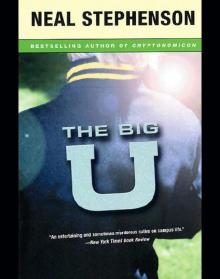 The Big U
The Big U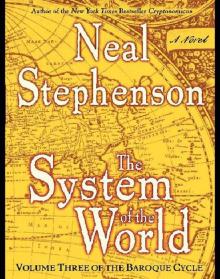 The System of the World: Volume Three of the Baroque Cycle
The System of the World: Volume Three of the Baroque Cycle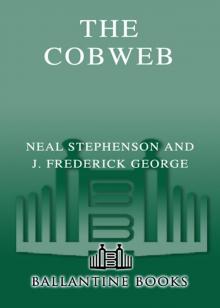 The Cobweb
The Cobweb Reamde
Reamde Fall; or, Dodge in Hell
Fall; or, Dodge in Hell Interface
Interface Quicksilver
Quicksilver The Mongoliad: Book Three
The Mongoliad: Book Three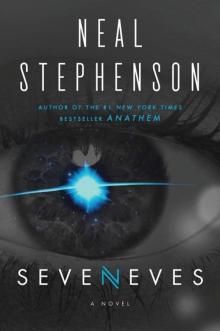 Seveneves
Seveneves Atmosphæra Incognita
Atmosphæra Incognita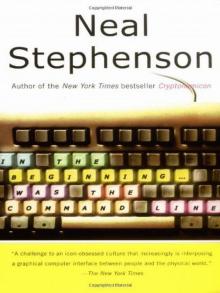 In the Beginning...Was the Command Line
In the Beginning...Was the Command Line Anathem
Anathem The Rise and Fall of D.O.D.O.: A Novel
The Rise and Fall of D.O.D.O.: A Novel The Mongoliad: Book Two
The Mongoliad: Book Two Diamond Age or a Young Lady's Illustrated Primer
Diamond Age or a Young Lady's Illustrated Primer THE System OF THE WORLD
THE System OF THE WORLD The Mongoliad: Book One tfs-1
The Mongoliad: Book One tfs-1 Some Remarks: Essays and Other Writing
Some Remarks: Essays and Other Writing Zodiac
Zodiac Spew
Spew The Baroque Cycle: Quicksilver, the Confusion, and the System of the World
The Baroque Cycle: Quicksilver, the Confusion, and the System of the World The Diamond Age
The Diamond Age Reamde: A Novel
Reamde: A Novel In the Kingdom of Mao Bell
In the Kingdom of Mao Bell Mother Earth Mother Board
Mother Earth Mother Board Twelve Tomorrows - Visionary stories of the near future inspired by today's technologies
Twelve Tomorrows - Visionary stories of the near future inspired by today's technologies The Confusion
The Confusion The Great Simoleon Caper
The Great Simoleon Caper The Mongoliad: Book Three tfs-3
The Mongoliad: Book Three tfs-3